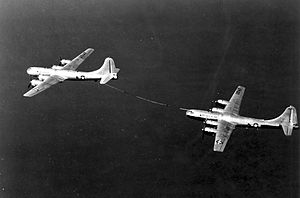Boeing KB-29 Superfortress
| KB-29 | |
|---|---|
 |
|
| KB-29M refueling KB-29MR | |
| Role | Strategic Tanker |
| Manufacturer | Boeing |
| Introduction | 1948 |
| Status | retired |
| Primary user | United States Air Force |
| Produced | 92 KB-29M, 74 KB-29MR, 116 KB-29P |
| Number built | 282 total conversions |
| Developed from | B-29 Superfortress |
The Boeing KB-29 was a modified Boeing B-29 Superfortress for air refueling needs by the USAF. Two primary versions were developed and produced: KB-29M and KB-29P.
The 509th and 43d Air Refueling Squadrons (Walker AFB, NM and Davis-Monthan AFB, AZ respectively) were created in 1948 to operate the KB-29M tankers. The 303d Bombardment Wing at Davis-Monthan AFB flew B-29s and KB-29s from 1951 to 1953 that provided training for strategic bombardment and air refueling operations to meet SAC's global commitments. Deployed at Sidi Slimane AB, French Morocco, Oct 5 - Nov 6, 1952.
The B-29 played an important role in developing the effective use of aerial refueling during the late 1940s. The first aircraft involved in this programme were the KB-29M tanker and B-29MR receiver. At first, a grappling system, known as the looped hose method, was used; the tanker would formate behind, above and to the left of the receiver. It would then unreel a hauling cable attached to a 55lb weight (to make it dangle near vertically). The receiver would trail a hauling cable ending in a drag cone (to make this trail near horizontally) and a grapnel. With both cables trailed, the tanker would cross to the right of the receiver so the two cables snagged each other. With cables snagged, the tanker hauled both into its fuselage where the receiver's cable was connected to the tanker's hose. This was then hauled into the receiver. After connecting with internal fuel compartments pumping would begin. When the receiver was full the process was reversed allowing the tanker to recover its hose and the receiver its hauling cable. While this system was clumsy, it was often used in the late 1940s before a better system was developed. It was most notably used to refuel the Lucky Lady II during her famous circumnavigation of the globe in 1949. The ability of the USAF to circumnavigate the globe demonstrated that its bombers could strike at any target. This helped sway the argument as to whether the USAF or US Navy should provide the US's nuclear delivery capability. The USAF won with the consequential massive expansion of the USAF's Strategic Air Command and cancellation of the US Navy's super carriers.
...
Wikipedia
